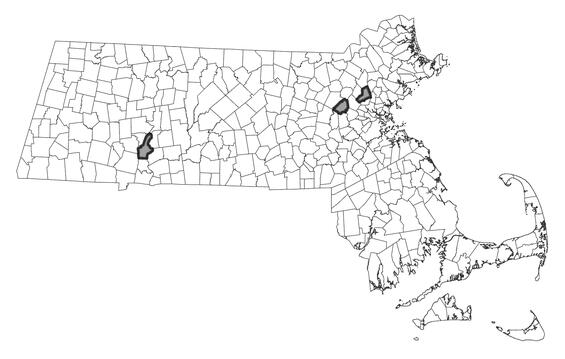- Scientific name: Doellingeria infirma
- Species of Greatest Conservation Need (MA State Wildlife Action Plan)
- Endangered (MA Endangered Species Act)
Description
The cornel-leaved aster (Doellingeria infirma) is a slender, erect, perennial herb of the aster family (asteraceae). It grows from about one to three feet tall (4 to 11 dm [1.3-3.6 ft]) with a single, smooth, somewhat zig-zag stem. It has a somewhat flat-topped inflorescence of white “flowers,” which are actually composites (called “capitula”) of many smaller flowers. This species flowers from late July to September.
The cornel-leaved aster derives its latin specific epithet infirma from its slender stem, which is weak relative to stouter asters. The leaves of this weak aster are 6-13 cm (2 -5 in) long and are elliptical in shape. The margins are entire (not toothed) and are smooth except for pubescent veins beneath. The leaves are few in number, are alternately arranged, and are essentially the same size along the length of the stem. The flower heads (capitula) are about 3 cm (1 in) across with 5-12 broad, white rays. In many members of the aster family, what appear to be fringing petals are actually tiny flowers called “ray flowers” or “rays.” The capitula are arranged in a corymb-like (somewhat flat or round-topped) inflorescence. The fruit is a hairless achene (a small, dry fruit with a single seed) topped by two sets of bristles: a long inner whorl and a much shorter outer one.
There are several asters that superficially resemble the cornel-leaved aster, and therefore it is best to consult a technical manual when identifying asters. A few common, similar-looking, white asters that may be separated easily from the cornel-leaved aster include the flat-topped white aster (Doellingeria umbellata), and the toothed white-topped aster (Sericocarpus asteroides). The flat-topped white aster is a larger plant (10-20 dm [3.3-6.5 ft]) of lowlands. It has more copious leaves that are much rougher than the smooth leaves of the cornel-leaved aster. In addition, the achenes of the flat-topped white aster are sparsely pubescent, while those of the cornel-leaved aster are glabrous. The toothed white-topped aster has toothed leaves, smaller flower heads, and pubescent fruit.
Life cycle and behavior
This is a perennial herb.
Population status
The cornel-leaved aster is listed as Endangered under the Massachusetts Endangered Species Act (MESA). All listed species are protected from killing, collecting, possessing, or sale and from activities that would destroy habitat and thus directly or indirectly cause mortality or disrupt critical behaviors. In Massachusetts, this aster has been reported from Hampden, Worcester, and Middlesex Counties. Only four stations of this species are currently known in Massachusetts. This species was once known from Rhode Island but is now considered historic in that state. One reason for its rarity in Massachusetts, and throughout our region, is that the species is near the northern limit of its range.

Distribution in Massachusetts
1999-2024
Based on records in the Natural Heritage Database
Distribution and abundance
The cornel-leaved aster ranges from Massachusetts west to Ohio, south to South Carolina, Georgia, and Alabama.
Habitat
Cornel-leaved aster has been found on non-acidic, dry to dry-mesic, rocky, wooded slopes in partial shade. Species often associated with this aster include hickories (Carya ovata and C. tomentosa), oaks (Quercus rubra and Q. alba), tick-trefoils (Desmodium spp.) and goldenrods (Solidago spp.). In Massachusetts, this aster usually is found growing in woods with an open shrub layer and a moderately open tree canopy.
Healthy habitats are vital for supporting native wildlife and plants. Explore habitats and learn about conservation and restoration in Massachusetts.
Threats
Invasive exotic plant species of forest understories, such as Japanese barberry (Berberis thunbergii) or common barberry (Berberis vulgaris), may compete with this aster for resources. Animal browse, likely by deer or rabbit, has been observed on this species of aster and can be a threat at excessive levels.
Conservation
As for many rare species, the exact needs for management of the cornel-leaved aster are not known. The following comments are based primarily on observation of populations in Massachusetts. Invasive species should be controlled where they compete with rare species. Fencing exclosures to prevent browse may benefit this aster at certain locations. Given that the species typically occurs in dry, rocky places, the role of fire in maintenance of the species habitat or in stimulating its seed to germinate should be investigated. While the cornel-leaved aster may benefit from some canopy thinning, it likely requires a partially shaded habitat, and hence the extremes of dense shade or drastic canopy clearing should be prevented. All active management within the habitat of a rare plant population (including invasive species removal) is subject to review under MESA and should be planned in close consultation with MassWildlife’s Natural Heritage & Endangered Species Program.
Contact
| Date published: | April 14, 2025 |
|---|